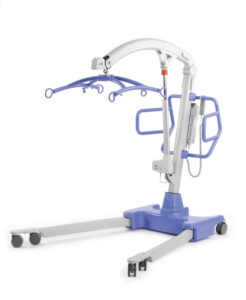The handling of bariatric patients presents a number of unique challenges. Not least the provision and cost of more niche equipment and additional staffing requirements. Bariatric people may also have associated medical conditions. Therefore, they demand careful consideration when planning lifting and mobilisation activities. This is generally the case with bariatrics. For instance, more than one care-giver is in need to assist in patient mobilisation. In addition, operation of the equipment, again, mainly due to the increased loads involved.
Depending on individual needs, a care plan may dictate that a hoist is an essential part of their daily routine. It may be the only way, for example, for them to get in and out of the bath, bed, or even stand up from a chair. For others, it may be used more, in isolation, for specific needs, or for rehabilitation purposes. These decisions are entirely dependent on the risk assessed needs of the person requiring care. Conducting an individual risk assessment is especially important for bariatric patients.
Bariatric Hoist Considerations

When considering solutions to support the lifting and moving of bariatric patients, a mobile hoist will likely be one of the choices. Due to the nature of mobile bariatric hoists, their size usually dictates the environment in which they can be used effectively. In most cases, acute or large nursing facilities lend themselves to being more suitable. This is purely from a space perspective if nothing else.
 Additionally, mobile hoists help ensure that those who are caring for the patient, have a safer, risk-mitigated method of carrying out demanding moving and handling tasks. Especially without causing unnecessary physical strain and/or injury. The benefits to this include reduced injuries to care staff and less lost time and resources. Consequently, resulting in more cost effective and sustainable care in the longer term.
Additionally, mobile hoists help ensure that those who are caring for the patient, have a safer, risk-mitigated method of carrying out demanding moving and handling tasks. Especially without causing unnecessary physical strain and/or injury. The benefits to this include reduced injuries to care staff and less lost time and resources. Consequently, resulting in more cost effective and sustainable care in the longer term.
When choosing a bariatric hoist, the patient weight will be a dominating factor in the decision making process. All lifting hoists have a safe working load rating, limiting the amount of weight they can safely carry. Lifts designed for bariatric patients are usually more specialised devices. They are able to withstand the increased demands that higher loads bring.
The Oxford Calibre Bariatric Mobile Lift
Here at Joerns Healthcare, we have a wide range of lifting and handling solutions. We ensure we can accommodate a wide range of patients and their personal requirements. Our bariatric mobile hoist, the Oxford Calibre, has been specifically designed for bariatric patients. In addition, it offers all of the usual benefits of a regular hoist. However, it has a significantly larger lifting capacity.
The Benefits Of The Bariatric Hoist
The Calibre, like all Oxford Professional lifts series, has been ergonomically designed. Close attention has been paid to the positioning of patient and carer interaction points. For instance, the over-sized push handle, purposely designed for multi-carer use. It is incredibly sturdy and robust. Additionally, for a mobile lift, it has one of, if not the highest safe working loads in the market today at a whopping 385kg (850lbs)!
An integrated Class III digital weigh-scale, as standard, enables precision weighing of patients for medication provision. As well as, other on-going checks. This ensures weight monitoring can be conducted in harmony with lifting and transfers. Therefore, saving time and effort where separate weighing devices are otherwise in need.
It has a large 6-point cradle which offers greater space and comfort for larger users. Powered leg positioning reduces the effort required on behalf of the carer to open and close the legs. Also, providing excellent access around furniture and other equipment. Twin pivoted front castors help with manoeuvrability and navigating room thresholds and uneven surfaces, particularly under load.
We strive to bring the highest levels of safety and convenience to our products. Therefore, the Calibre is also equipped with the Smart Monitor diagnostic and service controls. On-board LCD read-out shows lift cycles completed, work completed by the lifting actuator and attempted overloads (above safe working load). In addition, a service reminder countdown to ensure your lift is maintained in accordance with local country requirements.
Related: The Oxford Advance – Compact Folding Hoist
Clinical Trials & Testing
This unique lift was fully tried and tested at the Kidderminster Hospital. With the kind help of Barry Austin who weighed 47 stone at the time. Our engineers, trusted consultants and specialist teams worked alongside Barry and the Oxford Calibre. We ensured all safety, comfort and ergonomic criteria was thoroughly reviewed and addressed. In addition, a bespoke range of bariatric slings, specifically for use with the Oxford Calibre were also under review.
These real-world, pre-launch trials took place with many different transfers from bed to chair and reverse. This was in order to make sure the solution was both safe and effective. Barry was delighted with the lift and its capabilities. He also remarked that he felt he could “Sit for an extended period on the sling in a chair without discomfort”.
For more insight, please read our Case Study – Oxford Bariatric Care
Bariatric Mobile Hoist At Joerns Healthcare | Contact Us Today
For more information on the Oxford Calibre, a lift for bariatric patients, head to our website today. Or, call 0344 811 1158 to speak to a member of our helpful and friendly team.
If you have found this blog helpful, then you may wish to read our previous blog on Types Of Hoists.



